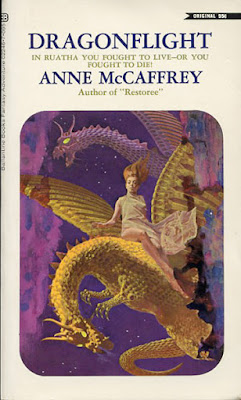Book Review: 'The Dragonriders of Pern' by Anne McCaffrey
3 / 5 Stars
This hardcover Omnibus (751 pp) was published by Doubleday under the Science Fiction Book Club imprint in October of 1978. The cover illustration is by Ron Dilg. It contains 'Dragonflight' (1968), 'Dragonquest' (1971) and 'The White Dragon' (1978).
The 'Pern' franchise now consists of over 25 novels and short story collections, some of which have been written by McCaffrey's son Todd, and her daughter Gigi (Anne McCaffrey died in 2011).
I never read any of the Pern novels when they first appeared, because I thought they were cheesy - I mean, people riding around on pet dragons ? Weren't dragons supposed to be menaces to health and welfare ?
(For a less-than-complimentary review by sci-fi blogger M. Porcius of 'Dragonflight', the first entry in the Pern series, readers are directed here. Pern enthusiasts may be offended.)
But, after the passage of 50 years, what with the Pern novels falling within the period of time (1968 - 1988) that this blog covers, I thought that I was obliged to sit down and read through at least the first three volumes in the series.........a task that took me a good seven weeks to accomplish.
The books have an interesting premise: over the centuries, the Terran colony on the planet Pern has regressed to a medieval level of civilization. But Pern remains threatened by its twinned planet, known as the Red Star, whose orbit periodically (every 200 years or so) brings it close to Pern. At such times, a fungus known as the Thread launches its spores from the Red Star, across interplanetary space, to Pern. As the spores descend through the atmosphere of Pern they convert to hyphae; should these land in the soil, they will consume all organic matter. If left unchecked, the Thread can convert an entire continent into a sterile wasteland.
Fortunately, the colonizers of Pern bioengineered the planet's small, indigenous flying lizards into 'dragons' capable of breathing fire and teleportation, as well as telepathic contact with their human riders. With the advent of Thread, together the dragonriders of Pern and their mounts rise to the skies and immolate the hyphae before they can land and take root. This is a struggle (the 'Pass') that lasts for as long as fifty years, before the Red Star's orbit moves the planet too far a distance for the spores to reach Pern.
The 'Dragonriders' trilogy recounts how, in the centuries with an absence of the Thread, the landholders of Pern have become increasingly resentful of having to support the dragonriders. The landholders have come to see the dragonriders as a caste of parasitic aristocrats who have outlived their usefulness.
F'lar, a young and ambitious dragonrider, chafes at the indifference to the threat of the Thread exhibited by his caste's leadership. But when ancient astronomical sites reveal the approach of the Red Star and the advent of the Thread, F'lar and his supporters realize that the fate of the planet now rests in their hands......but will they and their depleted forces of dragons be able to stop the onslaught ?
It's difficult to provide an in-depth, critical review of an Omnibus without disclosing spoilers, so I'll simply say that 'The Dragonriders of Pern' has its strengths and weaknesses.
Strengths: although writing during the heyday of the New Wave movement, McCaffrey keeps her prose direct and unencumbered by the myriad literary devices that many authors of that era were fond of indulging in.
For example, when the dragons and their riders teleport from one location to another, a procedure known as going between, McCaffrey avoids recounting these events in lengthy passages of figurative prose designed to communicate the psychological and physical turmoil associated with displacement in time and space (as Roger Zelazny was fond of doing with his 'Amber' novels).
Another strength of the trilogy are the characters of the dragons themselves; McCaffrey succeeds in giving these reptiles personalities and behaviors (that often make them more appealing than the human characters).
The Pern trilogy suffers from a major weakness: the concept of dragons flying around and burning up a fungus isn't exactly conducive to an action-packed narrative. Accordingly, 90% of the narrative in the trilogy is devoted to chronicling inter- and intra- group melodramas between the dragonriders and the landholders. These melodramas often are presented through lengthy passages of dialogue, and within the first few chapters of 'Dragonflight', become both tedious and unavoidable, as they are the main features of all three novels.
My eyes often glazed over with the effort of trying to keep track of yet another passage in which F'lar and Lessa (or was it F'nor and Brekke ?) are debating yet another political crisis involving T'ron and T'gor and Kylara, during which they are joined by N'ton and Lytol and Jaxom, who are aggravated by another transgression on the part of Lord Fax or Lord Meron or Lord Toronas................mix in telepathic observations on the part of the nearby dragons (rendered in italic font), and you can see how trying to follow these rhetorical excursions can be troublesome.
However, in summing up, there's no getting around the fact that 'The Dragonriders of Pern' compiles three of the most successful sci-fi novels of the decade between 1968 - 1978 and no survey of the genre is complete without acknowledging this. Given that other trilogies from the same period that were given a favorable critical reception - and here Asimov's 'Foundation' books comes readily to mind - were pretty mediocre in comparison, a three-star score for the 'Dragonriders' is appropriate.
Friday, March 6, 2020
Subscribe to:
Post Comments (Atom)






























No comments:
Post a Comment